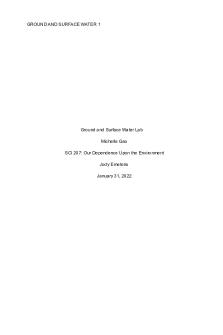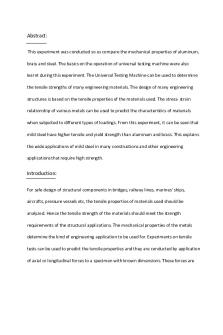Climatography Lab - Lab of comparing temperature and water levels. PDF

| Title | Climatography Lab - Lab of comparing temperature and water levels. |
|---|---|
| Author | Lily Langley |
| Course | Environmental Economics |
| Institution | University of Georgia |
| Pages | 6 |
| File Size | 410.9 KB |
| File Type | |
| Total Downloads | 45 |
| Total Views | 172 |
Summary
Lab of comparing temperature and water levels....
Description
Lily Langley Mrs.Kraj 3/15/20 Climatography Lab Purpose: The purpose of the lab is to analyze the relationship rainfall and temperature variance has on global biomes and to recognize biomes using a climatograph. Introduction/Background Information: Temperature and precipitation can be used to distinguish one biome from another. A climatograph shows temperature and precipitation over a year for a given area. The temperature is measured in celsius and temperature is measured in centimeters. Procedure: I graphed the precipitation and temperature for the four locales climatograph sheets, including the title of which number data table it is derived from and the biome I predict it’s in. I put temperature on the right side as a line graph and precipitation on the left as a bar graph. Then I used that data to predict which biome each graph represented. Then, I added the 6 provided climatographs to the lab report. Then I graphed the data for San Francisco and compared it with my existing graphs to find that it most closely resembles the shape of the line graph and bar graph from the Mid-Latitude Desert in Reno, Nevada.
San Francisco
Most Similar To:Reno, Nevada Prediction: Middle Latitude Desert Reflection: Which of the known biome climatographs closely resembles San Francisco? Mid Latitude Desert of Reno, Nevada In what ways were they similar? The precipitation peaked in the winter months of November, December, January, and February amounts of rain less than 5 cm, but had close to 0 cm of rain in the summer, creating a similar shape with the bar graph. Temperature wise, both line graphs created somewhat of a bell curve, peaking in the range of 20 degrees celsius and decreasing to more moderate, not as hot temperatures. In what ways were they different? While the shapes of their rain and temperature distribution are similar, they are different when it comes to their range and actual data points. For instance, The precipitation in San Francisco seems to be on average higher than Nevada because it peaks at 4.5 cm while Nevada peaks around 2.5 cm. That being said, they still both have extremely low precipitation ranges. Also, San Francisco also has somewhat higher temperatures than Nevada. San Francisco's highest temperature is 21 degrees and lowest is 13, while in Nevada, the highest temperature is around 18 degrees celsius, but the lowest is around 0 degrees celsius. Would you consider them to truly be the same biome? Explain? I would consider them to be in the same biome, because the average temperature for a Mid Latitude Desert is around 18 degrees celsius, which falls in the range of both of these areas. Also, their precipitation follows the exact same pattern of increasing in the winter and decreasing in the summer. During the 30-year period used for the figures in the San Francisco climatograph, there were four drought periods. How would this affect the appearance of the climatograph? The 4 drought periods would cause the rain bar graph to be close to zero for their respective months, which is similar to what is already occurring, in the summer months. The only difference may be that there will be periods where the bar graph is not present at all, like in the Tundra climograph. How are the tundra and desert similar? Different? Both of them receive around 250 mm of rain a year and have land and extremely dry climates that are not suitable for most plants and animals without adaptations. A difference is that while the tundra temperatures range from 40°C to 18, desert temperatures are lower at 38°C to –3.9°C.. Also while the tundra contains permafrost that prevents trees with deep roots from growing, the desert contains several trees with deep tap roots to absorb water. How are the tropical rain forest and tropical deciduous forests similar? Different? Similar: Their highest temperatures are similar (deciduous=30 degrees, rainforest=25 degrees). Rich in plant life. Species diversity.
Different: deciduous forest has richer soil, deciduous has a greater range of temperatures –30°C to 30°C while rainforest has 20°C to 25°C. Rainforest has much more rain (2,000 and 10,000 mm compared to Deciduous 750 to 1,500 mm). Lawrence, Kansas, and Nashville, Tennessee, occupy similar latitudes. Why is one found in a grassland and the other in a forest biome? The reason for the different biomes is because a biome is distributed by temperature and rainfall. It is not determined by latitude.
How would you determine which biomes are located in the southern hemisphere? I would look at their latitudes, because you can only use temperature and precipitation to determine the biome, not the hemisphere. Multiple biomes can be located within one hemisphere, so the only way to determine hemisphere is through latitude Which biome has the: most rainfall? Tropical rainforest least rainfall? Desert the highest average temperature? Tundra and Desert the lowest average temperature? Taiga most consistent year-round temperature? Tropical Rainforest most variable year-round temperature? Taiga and Temperate Deciduous Forest Summary: In this lab, I learned that climate (temperature and precipitation) determine what biome a location is in, and not the latitude or hemisphere it is in. Locations within the same biome follow similar patterns, even if the temperatures or rainfall may vary slightly. For example, the precipitation in San Francisco seems to be on average higher than Nevada because it peaks at 4.5 cm while Nevada peaks around 2.5 cm but, they still both have extremely low precipitation ranges that decrease in the summer and increase in winter, Though their latitudes are different, they are still in the same biome. If I were to do this lab again, I would use the same scale of temperature and rainfall on every graph to make them easier to compare their shapes. Not using the similar scale is what made my San Francisco graph have an odd shape as far as temperatures go that made it difficult to compare to the other climatographs. If there were any errors, they were likely due to rounding the data points on the graphs or from the confounding variable that travel was not taken into consideration in this experiment...
Similar Free PDFs

Properties of Water Lab
- 8 Pages

Properties of Water Lab Report
- 2 Pages

Ground and Surface Water Lab
- 8 Pages

Water Balance Lab report
- 14 Pages

Water Quality Lab Report
- 7 Pages

Water Pollution lab report
- 10 Pages

Water Hardness Lab Report
- 5 Pages

Water Potential Lab
- 4 Pages
Popular Institutions
- Tinajero National High School - Annex
- Politeknik Caltex Riau
- Yokohama City University
- SGT University
- University of Al-Qadisiyah
- Divine Word College of Vigan
- Techniek College Rotterdam
- Universidade de Santiago
- Universiti Teknologi MARA Cawangan Johor Kampus Pasir Gudang
- Poltekkes Kemenkes Yogyakarta
- Baguio City National High School
- Colegio san marcos
- preparatoria uno
- Centro de Bachillerato Tecnológico Industrial y de Servicios No. 107
- Dalian Maritime University
- Quang Trung Secondary School
- Colegio Tecnológico en Informática
- Corporación Regional de Educación Superior
- Grupo CEDVA
- Dar Al Uloom University
- Centro de Estudios Preuniversitarios de la Universidad Nacional de Ingeniería
- 上智大学
- Aakash International School, Nuna Majara
- San Felipe Neri Catholic School
- Kang Chiao International School - New Taipei City
- Misamis Occidental National High School
- Institución Educativa Escuela Normal Juan Ladrilleros
- Kolehiyo ng Pantukan
- Batanes State College
- Instituto Continental
- Sekolah Menengah Kejuruan Kesehatan Kaltara (Tarakan)
- Colegio de La Inmaculada Concepcion - Cebu







